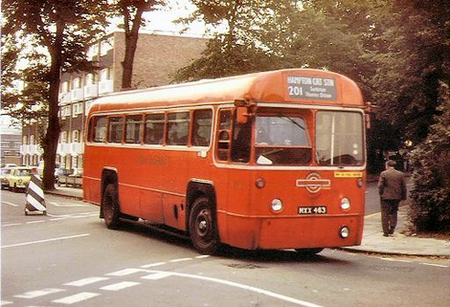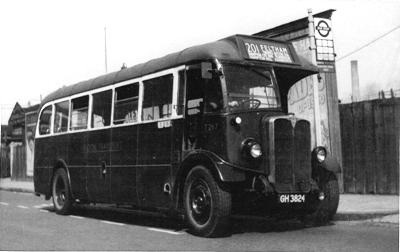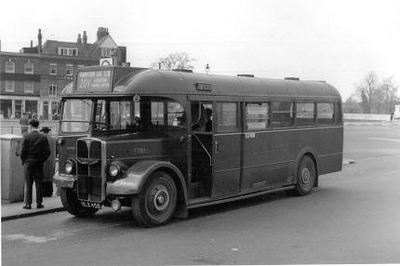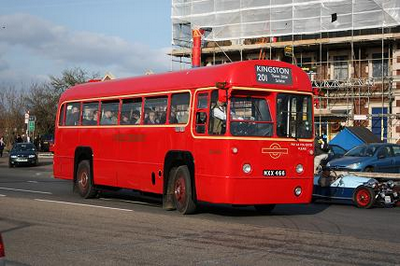|
|
 Red RF routes Red RF routes
Route 201
Page last updated 14 January 2020
Notable for a while for occupying no less than three
garages to run a route needing at most 5 buses, the 201 was also
one of first four Central Area routes converted to 'big bus'
one-man operation in London, in 1964.
RF486 on the 201, on diversion in
Kingston in about 1970. It is using Denmark Road and Portland
Road to reach Villiers Road, instead of Fairfield South.
Photo Ian Armstrong
collection
Dates of RF operation
12 Oct 55 to 19 Nov 58 (Sun only)
and
13 May 59 to 6 Nov 76
Converted to OMO 18 Nov 64
(total 20 years 7 months, of which 8 years 7
months crew operation).
Destinations
KINGSTON and HAMPTON COURT STATION
RF Garages
Crew operation:
NB Norbiton (Sun from 12 Oct 55 to
19 Nov 58, daily from 13 May 59 to 8 May 62, Mon-Sat 9 May 62
to 17 Nov 64)
K Kingston (Sun 9 May
62 to 17 Nov 64)
OMO operation:
NB Norbiton (daily 18 Nov 64 to 11
May 73, Mon-Fri 12 May 73 to 6 Nov 76)
FW Fulwell (weekends
12 May 73 to 19 Aug 76)
K Kingston (Sat 10 Apr
76 to 6 Nov 76)
Reason for single-deck operation
The low bridge at Thames Ditton Station, which remains
unchanged to date.

One of the miscellany of types working from
Kingston garage in the years after the war was former Green Line
11T11 coach T267, repainted red in 1946. It is seen here at
the alighting point in Wood Street, Kingston, prior to returning to
Feltham.
Photo Peter Osborn collection
Route history
Although known as a Kingston local route, the 201 stated life
as Hounslow local route 105. Registered in 1930 but not
started until June 1931, the route ran from Hounslow Garage via the
newly-developing areas of Lampton and Heston in a loop round
to Hounslow West and Hounslow Central. Hounslow used
two (possibly one-man operated) Darts daily. In October,
the route was extended south from Hounslow Garage to Hanworth, then
in the following January to Teddington Station and the Darts were
replaced by single-deck Ss. The frequency had now been
doubled as well.
The Ss were in turn replaced by LTL Scooters from November
1932, when they became available from a programme of speeding up
schedules following the widespread use of pneumatic-tyred
buses. However, the 1933 summer schedules called for more
Scooters at Holloway for the 110, so
smaller Ts replaced the LTLs. Three more were found, then
lost again when the 551 (later 251) was
extended.
June 1933 saw the route extended again, finally reaching
Kingston via Bushy Park and Thames Ditton on the opening of Hampton
Court Bridge. The section between Kingston and Thames Ditton
had previously been covered, since introduction in April
1928, by the 171 (later 214) which
continued to Molesey, Walton and Chertsey, and which was rerouted
from Kingston via Hampton Court Road also using the new
bridge. The extra buses required were initially Ts provided
by Twickenham garage (AB), not by Kingston, which brief spell
appears to have been AB's only single-deck operation until the
290 in 1968. These worked alongside
LTLs and/or Ts from Hounslow (AV); it is known that AV sometimes
borrowed Ts from Uxbridge (UX) at weekends.
 Green T788 - a 15T13 and
much superior to the red 14T12s - was one of a number loaned to
Norbiton for the 201. It is seen in 1957 at Hampton Court
Station. Note the use of the nearside route stencil -
possibly for the only time in the buses' life, as these were
not used in the Country Area.
Photo © PM
Photography
The section north and west of Lampton was removed on 17 Jan
34, becoming a double-deck circular route that was later absorbed
into the 111, which still covers much of the section. At the
same time, AB was replaced by Kingston (K), initially using
Ts. Both K and AV swapped Ts for LTLs a week later, in
an exchange with ED and SP affecting routes 109 (later 227) and 195 (later 228).
The 105 was renumbered as
201 in October 1934, the route running every 15 minutes from
Kingston via Hampton Court and Hanworth to Hounslow and
Lampton. Now included in the AV allocation were extra weekend
buses for Hounslow to Hanworth short workings; in the
spring of 1936, these journeys were replaced by double-deck
workings with STs (AV, Mon-Sat) and STLs (Hanwell HW,
Sun).
This section of the route became the 110 when the 201 was
shortened in May 1936, with the Hanworth to Teddington section
becoming new route 255 and the 201 going
no further than Hampton Court. The route was
re-extended, on Sundays from August 1936 then daily from October
1937, via Hanworth to Feltham, replacing the short-lived 255.
The route was cut back again in June 1951 from Feltham to Hampton
Court, and in the following year the allocation moved from Kingston
to Norbiton when the latter garage opened.
Through these changes, the core route between Kingston and
Hampton Court served the back roads east and west of Surbiton that
became the 201's trade mark. The route was one of the
recipients of new 14T12s in 1946, when Kingston received the second
batch (after Uxbridge for the 223).
As was often the case with the Kingston area's single-deck routes,
there was considerable shuffling of vehicle allocations before the
advent of RFs, with post-war Ts and TDs both operating in the late
40's and the 50's. A number of green post-war 15T13s were
loaned to Norbiton from the Country Area for the 201, various
examples running from 1957 through to full RF conversion in
1959.
Kingston's RF458 leaving
Hampton Court along Creek Road towards East Molesey, on a wet last
day of RF operation, Saturday 6 Nov 76. The nearside
route number shows this is a new BL blind.
Photo ©
John Parkin
RFs were introduced at first on Sundays only, officially from
October 1955, by which time the 213 was
fully RF operated and the increased RF allocation at
Norbiton provided the 3 spare buses required on Sundays.
Briefly in 1958-59, the Mon-Sat allocation reverted to Kingston, at
which point the Sunday Norbiton allocation reverted to TD, but the
route was fully converted to RF in 1959, again fully from NB.
A Sunday Kingston allocation reappeared in 1962, up to OMO
conversion in 1964. This was one of the first four 'big bus'
OMO routes in London (there had been one-man buses before the war, using 20-seat Leyland Cubs and
their predecessors), the others being the 206 and 216 in the
Kingston area and the very rural 250 out
of Romford North Street.
In 1973, the garage allocations started to change again, firstly
with Fulwell taking over weekend workings, then in 1976 Kingston
took part of the Monday to Saturday allocations, leading to the
position when a route needing at most 5 buses was operated out of
three garages. Operations were converted to BL in August (the
weekend FW allocation) and November that year, leaving only the
jointly worked 218/219 in the Kingston area as RF operated.
The route withered and died not long after, but not before a
Mon-Fri peak hour variation to serve Lower Green at the back of
Esher, following withdrawal of the 206. The route ended in September 1980,
being replaced in part by an independent operator and by a
single extra journey on the (already heavily distorted) 215.
1961 bus map © London
Transport
RF route in detail, with timing points
KINGSTON Bus Station, Clarence Street, Fairfield
West, Fairfield South, Villiers Road, Lingfield Avenue, Beaufort
Road, Maple Road, Claremont Road, Surbiton Station, Victoria Road,
Brighton Road, Balaclava Road, Effingham Road, Ewell Road,
Thorkhill Road, Long Ditton
Portsmouth Road, St Leonard's Road, High Street,
Station Road, Thames Ditton
Station, Ember Court Road, Ember Lane, Esher Road,
Bridge Road, HAMPTON COURT STATION (return via Creek Road, Bridge
Road) (to 30 Jun 64)
KINGSTON Bus Station, Clarence Street (return via
Clarence Street, Wood Street), Fairfield West, Fairfield South,
Villiers Road, Villiers Avenue, Lamberts Road, St Mark’s Hill,
Surbiton Station,
Victoria Road, Brighton Road, Balaclava Road, Effingham Road, Ewell
Road, Thorkhill Road, Dittons
Winters Bridge, St Leonard's Road, Thames Ditton
High Street, Station Road, Thames
Ditton Station, Ember Court Road, Ember Lane, Esher
Road, Bridge Road, HAMPTON COURT STATION (return via Creek Road,
Bridge Road) (from 1 Jul 64)
Garage journeys (Fulwell): HAMPTON COURT STATION, Hampton
Court Road, High Street Hampton, Hampton Hill, Wellington Road,
FULWELL GARAGE
Frequency
| Year |
Mon-Fri |
Sat |
Sun |
| 1936 |
15 mins |
15 mins |
15 mins |
| 1938 |
15 mins |
15 mins |
15 mins |
| 1941 |
20 mins |
20 mins |
20 mins |
| 1946 |
15 mins |
15 mins |
15-20 mins |
| 1953 |
15 mins |
15 mins |
15-20 mins |
| 1959 |
20 mins |
20 mins |
31 mins |
| 1964 |
20-30 mins |
20-30 mins |
30-60 mins |
| 1969 |
17-22 mins |
21-22 mins |
30-60 mins |
| 1971 |
15-18 mins |
21-22 mins |
60 mins |
| 1976 |
15-20 mins |
24 mins |
62 mins |
From Kingston to Hampton Court the long way (compare
trolleybus 604, or even the 216!) took
about 27 minutes. The July 1967 timetable is
here.
Faretable
The faretable for May 1965 is here.
RF allocation
PVR 1955 (Oct): Mon-Fri [4 TD], Sat [4 TD], Sun 3
(NB)
PVR 1957 (May) to 1958 (Nov): Mon-Fri [4 T], Sat [4 T],
Sun 3 (NB)
PVR 1959 (May): Mon-Fri 3, Sat 3, Sun 2 (all
NB)
PVR 1961 (Aug): Mon-Fri 3, Sat 3, Sun 1 (all
NB)
PVR 1962 (May): Mon-Fri 3 (NB), Sat 3 (NB), Sun 2
(K)
PVR 1964 (Nov, OMO): Mon-Fri 4, Sat 5, Sun 2 (all
NB)
PVR 1965 (Aug): Mon-Fri 4, Sat 4, Sun 2 (all NB)
PVR 1967 (Jun): Mon-Fri 5, Sat 4, Sun 2 (all NB)
PVR 1969 (Oct): Mon-Fri 5, Sat 4, Sun 1 (all
NB)
PVR 1973 (May): Mon-Fri 5 (NB), Sat 4 (FW), Sun 2
(FW)
PVR 1976 (Apr): Mon-Fri 2 (K), 3 (NB), Sat 2 (K), 2
(FW), Sun 2 (FW)
PVR 1976 (Aug): Mon-Fri 2 (K), 3 (NB), Sat 2 (K), [2
BL] (FW), Sun [2 BL] (FW)
Memories
Stan Attewell started
work driving the 201 when it was crew-operated. Read his
memories here.
Ian Hogben tells
the story of a sweet old lady passenger...
'The Gremlin was an apparently sweet little old lady of some
one hundred and seventy-five years of age. At first glance she was
everyone’s idea of how you would expect your favourite Great,
Great, Great Grandma to look. WRONG! The Gremlin was probably the
most argumentative, objectionable, disagreeable, ungrateful being
who ever walked the planet. Whatever you did, she would find fault
with it, and if you got in her way, you were likely to get a poke
with her stick or umbrella. The Gremlin spoke with a squeaky,
rasping nasal voice and was equally unpleasant to drivers and
fellow passengers alike.
The Gremlin was a regular, travelling from Kingston Garage
(forecourt) to Winters Bridge, Thames Ditton (or Thorkhill Road
when the 201 used to go that way). When I first came across
her, her preferred route was the 201 (Kingston to Hampton Court via
Surbiton and Thames Ditton Village). This enabled her to alight in
Thorkhill Road, one stop before Winters Bridge.
When the 201 was withdrawn, and the 215 was rerouted from the Portsmouth Road, to
serve Surbiton, Hinchley Wood and Esher, the Gremlin became a
regular on routes 218 and 219 to and from Winters Bridge proper. Despite
her apparent frailty, she would have given Usain Bolt a run for his
money. As soon as she alighted, she would scurry off with the speed
of light, waving her stick to dispatch any who got in her way. And
(well aware of her unpleasant attitude to the world at large) if a
driver saw her coming, he’d be taking fares and issuing tickets
like a demon just on purpose to get away from the bus stop before
the Gremlin’s legs, whirring like a mosquito’s wings, carried her
to the door of the bus, at which time per poisonous tongue would be
unleashed. Even the other passengers did their bit, boarding as
quickly as they could to avoid becoming the object of the Gremlin’s
ire (their mere presence at the stop, or on the bus was sufficient
reason).
I remember one occasion when I was working an almost empty
Kingston bound 218/9, pulling up at Winters Bridge. I had spotted
the Gremlin already waiting. It didn’t matter who was first in the
queue, for she would elbow everyone else out of the way. However,
on boarding my bus, rather than paying her fare (no freedom passes
in those days) she suddenly stood transfixed. Someone was occupying
‘her’ seat and anyone in it was expected, nay REQUIRED to move.
(‘Her’ seat was the first lengthways seat immediately behind the
luggage rack.) The conversation went something like:
Gremlin, pointing her stick at the middle
aged woman said, in her rasping, nasal voice: "That’s my seat."
Woman, instead of moving to another seat,
gazed nonchalantly out of the window.
Gremlin, louder: "Didn’t you hear? You’re in
my seat. That’s my seat."
Woman, looking around at the rest of the
seats in the three-quarters empty bus still said nothing.
Gremlin (banging her stick several times
loudly on the rails of the luggage rack and making everyone jump):
"You’ll have to move. That’s my seat!"
Woman: "There are plenty of other
seats."
Gremlin: "But that’s my seat. I always sit
there."
Woman: "Well it’s not your seat today. I’m
sitting here."
Gremlin: "It’s my seat. I always sit there."
Then, turning to me: "Tell her driver. It’s my seat. Tell her
she’ll have to move."
Me: "Sorry luv. I can’t tell her to move.
She’s as entitled to the seat as you are. You’ll have to sit
somewhere else."
Gremlin: "I don’t like sitting anywhere
else."
Me: "Well if you won’t sit in one of the
other seats and the other lady won’t move, you’ll have to wait for
the next bus."
Eventually, after some considerable delay, the Gremlin paid her
fare and went and sat on the first transverse seat (next to the
gangway) on the right side of the bus, but the whole of the way to
Kingston, she kept up a diatribe about it being ‘her’ seat, bending
the ears of each and every subsequent passenger who boarded and
banging her stick on the floor in frustration.
On another occasion I was Kingston bound and packed to the
gunwales. Three standing might have been laid down in ‘the Rules’,
but at busy times we squeezed them in as best we could. This time
the Gremlin had boarded and cajoled ‘her’ seat’s occupant in to
giving it up, but she was not then best pleased that people were
standing along the gangway in front of her and she took it upon
herself to lay down the law.
Gremlin (to a young woman propped, half
sitting on the rail of the luggage rack beside her): "You can’t sit
there."
Young woman: "Why not?"
Gremlin: "You’re blocking the gangway.
People can’t get on and off."
Young woman: "No one’s getting on or off at
the moment and, when they do, I’ll move."
The Gremlin poked the young woman with her
stick. "You can’t sit there. The driver can’t see out."
Me: "Yes I can. She’s behind the glass
screen."
Gremlin: "She can’t sit there, it’s
dangerous for everyone. Make her move."
Me: "It’s not dangerous where she is and
anyway, where’s she supposed to move to? The bus is full."
Gremlin: "Well I want her to move because I
can’t see out."
This also went on all the way to Kingston.
Drivers’ revenge:
One afternoon I was up in the canteen, a few minutes before I
was due to take over on the garage forecourt when one of the
drivers who was always game for a laugh (and who I will call McD)
came up and told me the Gremlin was waiting for my bus. Another
driver with a wicked sense of humour (CP) then said: "Give us a
couple of minutes." With that McD and CP disappeared off
downstairs. They gave me no idea what they were planning.
As the 218s and 219s stand was at the far side of the garage
forecourt, the buses stood there with their doors closed until the
next driver arrived to take over, and he would let himself in
through the front doors on the air tap. When I got down to
the forecourt, there was the Gremlin, standing guard across the
door to prevent anyone else getting ‘her’ seat. She wasn’t even too
keen on the relief driver getting on first (I think she thought the
relief driver might be a prospective passenger in disguise).
As I opened the door and climbed the steps I noticed that I
already had two seated ‘passengers’, both with supremely confident
smiles. CP was sitting in the Gremlin’s seat and McD had taken the
only other seat she might be willing, albeit reluctantly, to
occupy. They had climbed in through the emergency door at the back
and sprinted, doubled-up so as not to be observed, down the length
of the bus. When the Gremlin boarded, the scene was an absolute
picture. I just stood and listened to the exchange of views that
went on between her and her two fellow ‘passengers’, with all the
usual: "That’s my seat" arguments. As it happened, McD was himself
due to take-over within a few minutes and, once all my legitimate
passengers had boarded, vacated the seat before I departed, but CP
stayed on until I reached the first stop in Eden Street. As soon as
CP got off to return to the garage, the Gremlin was down the bus
and into ‘her seat’ like greased lightening.
The Gremlin wouldn’t be helped, the Gremlin wouldn’t be told.
The Gremlin knew best.
Some time after the 215 had been permanently rerouted via
Surbiton, Hinchley Wood and Claygate to terminate at Esher, but
when it had been on a prolonged diversion of several months via
Giggs Hill Green while major road-works were being done in Sugden
Road, another incident happened. This diversion involved the bus
passing closer to where the Gremlin lived and so she had switched
to using the 215 service (giving the 218/9 drivers a break).
However, on this particular day, the works were finished and the
bus had reverted to its scheduled route.
I was working the 215 that day and the Gremlin was waiting for
me when I arrived to take over. Before she boarded I explained that
she didn’t now want the 215 as it no longer passed her door, but
she wouldn’t listen. She ‘knew’ it was the right bus and, no matter
what I said, she was adamant and insisted on boarding. I could
hardly bodily throw her off, so off we went.
On arrival at the junction of Effingham Road and Ewell Road
(where the diversion had previously started), I stopped and
enquired if she wanted to get off there, as it was now the nearest
point to where she lived. She ignored my question and despite more
explanations, kept insisting: "I want the next stop driver." I
again explained that the next stop was in Sugden Road, five hundred
yards in the opposite direction from where she wanted to be.
The Gremlin was having none of it.
I therefore turned left (on the scheduled route) instead of
right (on the previous diversion), but by the time I stopped at the
next stop (in Sugden Road) she was berating me for having "gone the
wrong way". She insisted on staying on the bus, saying she didn’t
know where she was, and demanding that I take her back and ‘go the
right way’. This lasted all the way to Esher, and all the way back.
On arrival back at her (now) nearest stop she still refused to get
off and still insisted I take her ‘the right way’. She finally
alighted at the terminus stop in Wood Street Kingston and made her
way back on foot to the garage forecourt. When I next saw her
(ten minutes later) she was busy telling everyone who would listen,
what a fool the last driver was because he didn’t know the route
and ‘went the wrong way’. As I passed by, she even told me about
the stupid driver who didn’t know his job. Meanwhile, she stood
guarding the next 215 due out, to make certain she got ‘her’
seat.
I later learned that much the same thing had happened with the
next driver. I don’t know how she eventually got home that day but
I believe the forecourt inspector may have got her a taxi (as much
for his health and wellbeing as for hers). At least the silver
badge earned his money that particular day!'
See these pages for more by Ian: 216, 218,
Operations.

Re-creation
RF489 was a Norbiton bus
and is shown working the 201 in 1975 here. In 2009, it returned to its old
haunts for the Kingston event, and is seen here departing
Hampton Court Station. Photo © Mark James
|
|